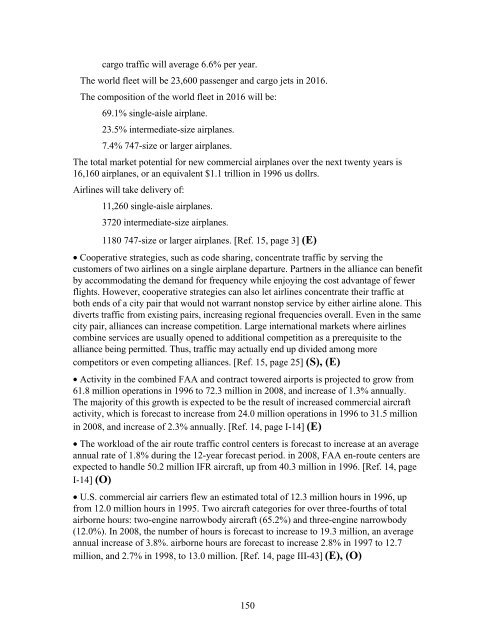Air Traffic Management Concept Baseline Definition - The Boeing ...
Air Traffic Management Concept Baseline Definition - The Boeing ...
Air Traffic Management Concept Baseline Definition - The Boeing ...
Create successful ePaper yourself
Turn your PDF publications into a flip-book with our unique Google optimized e-Paper software.
cargo traffic will average 6.6% per year.<br />
<strong>The</strong> world fleet will be 23,600 passenger and cargo jets in 2016.<br />
<strong>The</strong> composition of the world fleet in 2016 will be:<br />
69.1% single-aisle airplane.<br />
23.5% intermediate-size airplanes.<br />
7.4% 747-size or larger airplanes.<br />
<strong>The</strong> total market potential for new commercial airplanes over the next twenty years is<br />
16,160 airplanes, or an equivalent $1.1 trillion in 1996 us dollrs.<br />
<strong>Air</strong>lines will take delivery of:<br />
11,260 single-aisle airplanes.<br />
3720 intermediate-size airplanes.<br />
1180 747-size or larger airplanes. [Ref. 15, page 3] (E)<br />
• Cooperative strategies, such as code sharing, concentrate traffic by serving the<br />
customers of two airlines on a single airplane departure. Partners in the alliance can benefit<br />
by accommodating the demand for frequency while enjoying the cost advantage of fewer<br />
flights. However, cooperative strategies can also let airlines concentrate their traffic at<br />
both ends of a city pair that would not warrant nonstop service by either airline alone. This<br />
diverts traffic from existing pairs, increasing regional frequencies overall. Even in the same<br />
city pair, alliances can increase competition. Large international markets where airlines<br />
combine services are usually opened to additional competition as a prerequisite to the<br />
alliance being permitted. Thus, traffic may actually end up divided among more<br />
competitors or even competing alliances. [Ref. 15, page 25] (S), (E)<br />
• Activity in the combined FAA and contract towered airports is projected to grow from<br />
61.8 million operations in 1996 to 72.3 million in 2008, and increase of 1.3% annually.<br />
<strong>The</strong> majority of this growth is expected to be the result of increased commercial aircraft<br />
activity, which is forecast to increase from 24.0 million operations in 1996 to 31.5 million<br />
in 2008, and increase of 2.3% annually. [Ref. 14, page I-14] (E)<br />
• <strong>The</strong> workload of the air route traffic control centers is forecast to increase at an average<br />
annual rate of 1.8% during the 12-year forecast period. in 2008, FAA en-route centers are<br />
expected to handle 50.2 million IFR aircraft, up from 40.3 million in 1996. [Ref. 14, page<br />
I-14] (O)<br />
• U.S. commercial air carriers flew an estimated total of 12.3 million hours in 1996, up<br />
from 12.0 million hours in 1995. Two aircraft categories for over three-fourths of total<br />
airborne hours: two-engine narrowbody aircraft (65.2%) and three-engine narrowbody<br />
(12.0%). In 2008, the number of hours is forecast to increase to 19.3 million, an average<br />
annual increase of 3.8%. airborne hours are forecast to increase 2.8% in 1997 to 12.7<br />
million, and 2.7% in 1998, to 13.0 million. [Ref. 14, page III-43] (E), (O)<br />
150
















